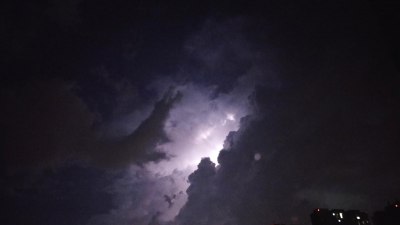The Mystery of Ball Lightning
Explore the enigmatic phenomenon of ball lightning, its theories, and recent scientific insights.

Ball lightning is a rare and poorly understood atmospheric electrical phenomenon that has intrigued both scientists and laypeople for centuries. Although it is often associated with thunderstorms and lightning strikes, there is no formal scientific consensus on its exact nature. Ball lightning appears as glowing, spherical objects that can vary in size and color, often described as floating or moving through space in unpredictable ways. This article aims to delve into the fascinating world of ball lightning, examining its history, potential explanations, and recent scientific findings.
Historical Background
The phenomenon of ball lightning has been documented in various cultures throughout history, often attributed to supernatural or mystical causes. One of the earliest recorded accounts comes from the 17th century when famous scientist Robert Boyle observed a fireball that resembled descriptions of ball lightning. Reports continued into the 19th century, with witnesses providing varying descriptions of the phenomenon’s appearance and behavior. Many incidents involved ball lightning appearing during or after thunderstorms, raising questions about its connection to more familiar forms of lightning.
The Nature of Ball Lightning
Despite centuries of observation, the true nature of ball lightning remains elusive. Typically described as luminescent spheres ranging from the size of a pea to that of a basketball, these phenomena can exhibit a variety of colors, including white, yellow, orange, and even blue. Observers have reported that ball lightning can hover, move along surfaces, change direction abruptly, and sometimes even explode or fizzle out without a trace. These unpredictable behaviors have fueled numerous theories regarding the underlying mechanisms of ball lightning.
Theories and Hypotheses
Several theories have been proposed to explain the characteristics and behavior of ball lightning. While none have been universally accepted, they provide insight into the scientific community's attempts to unravel this mystery. Some prevalent theories include:
- Plasma Theory: Some scientists theorize that ball lightning consists of plasma — a state of matter where gases become ionized. According to this model, electrical discharge during storms may create a stable plasma ball that can persist for short periods, generating light and heat.
- Chemical Reactions: Another theory suggests that ball lightning results from chemical reactions, specifically involving silicon and organic matter present on the ground. According to this hypothesis, certain environmental conditions may lead to the formation of glowing spheres as a byproduct of combustion or reaction.
- Microwave Cavity Theory: This intriguing hypothesis posits that ball lightning may form in pockets of microwave energy generated during lightning strikes. The idea is that a concentrated field of microwaves could manipulate matter within a confined space, producing glowing spheres of energy.
- Vortex Theory: Another interesting perspective involves the notion that ball lightning is a type of quasistable vortex formed by electrical currents. This theory suggests that the swirling motion of charged particles could sustain the ball lightning's shape and luminosity.
Scientific Investigations
Scientific inquiry into ball lightning has evolved significantly over recent years, especially with advancements in technology. Researchers have begun to document real-time data about ball lightning occurrences, thanks to improved sensor technology and high-resolution imaging. One notable study was conducted in 2014, where scientists used a high-speed camera to capture ball lightning in action. This research provided insights into the speed and movement characteristics of the phenomenon, although the precise mechanisms remained unclear.
Case Studies and Reports
Numerous reports and case studies have surfaced over the decades, highlighting various instances of ball lightning observed by people around the world. Some intriguing examples include:
- The 1960 Incident in the Soviet Union: A military unit reported encountering a transient glowing ball that floated inside their tent during a thunderstorm, causing panic among soldiers. While the phenomenon dissipated quickly, it left a lasting impression on those present.
- The 1980s Encounters: In the 1980s, multiple people in different locations across the United States reported seeing glowing orbs inside buildings during thunderstorms. These occurrences led to a flurry of interest, propelling research into the mechanisms behind ball lightning.
- The 2006 Airplane Incident: An airline pilot reported witnessing a glowing sphere outside the aircraft during turbulent weather, leading to questions about the safety of flying during thunderstorms. Though no one was harmed, it reignited conversation about the nature and implications of ball lightning.
The Role of Technology
Modern scientists have turned to technology to study the elusive nature of ball lightning more effectively. In recent years, researchers have utilized sophisticated imaging techniques, including high-speed cameras and infrared sensors, to capture the phenomenon in action. Additionally, the advent of machine learning and data analysis tools has empowered scientists to analyze thousands of reports and videos of ball lightning, searching for common patterns and characteristics.
Challenges in Research
The study of ball lightning is fraught with challenges. The unpredictable nature of the phenomenon makes it challenging to replicate under controlled conditions, leading to difficulties in conducting experiments or direct observations. Moreover, researchers often confront the problem of anecdotal evidence, as many reports lack sufficient scientific rigor. Furthermore, the oft-ambiguous descriptions of ball lightning can complicate the scientific understanding of the phenomenon.
Continued Mystique and Future Directions
Despite ongoing research, ball lightning continues to hold its mystique. As scientists push the boundaries of modern physics, new theories and technologies may emerge to unravel the enigma of this atmospheric phenomenon. The combination of interdisciplinary approaches — integrating physics, meteorology, chemistry, and technology — may yield fresh insights about the origins and characteristics of ball lightning.
In conclusion, the mystery of ball lightning remains one of the enduring enigmas of atmospheric science. Although numerous theories abound, definitive explanations are still elusive. The beauty and unpredictability of ball lightning have captured the human imagination, fueling myths and scientific inquiry alike. As research progresses and technology continues to evolve, we may finally uncover the truth behind this mesmerizing phenomenon that has fascinated humanity for centuries.











